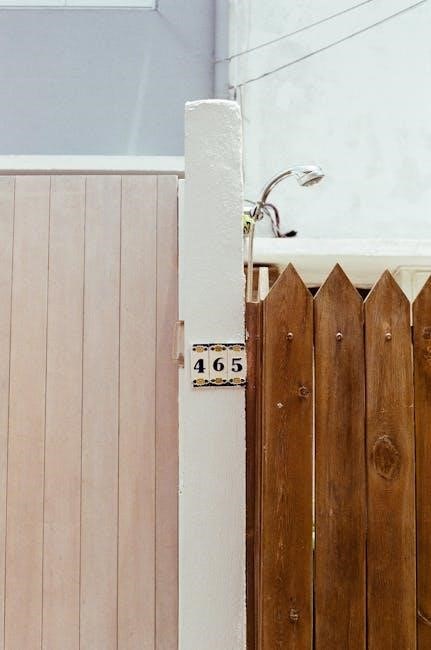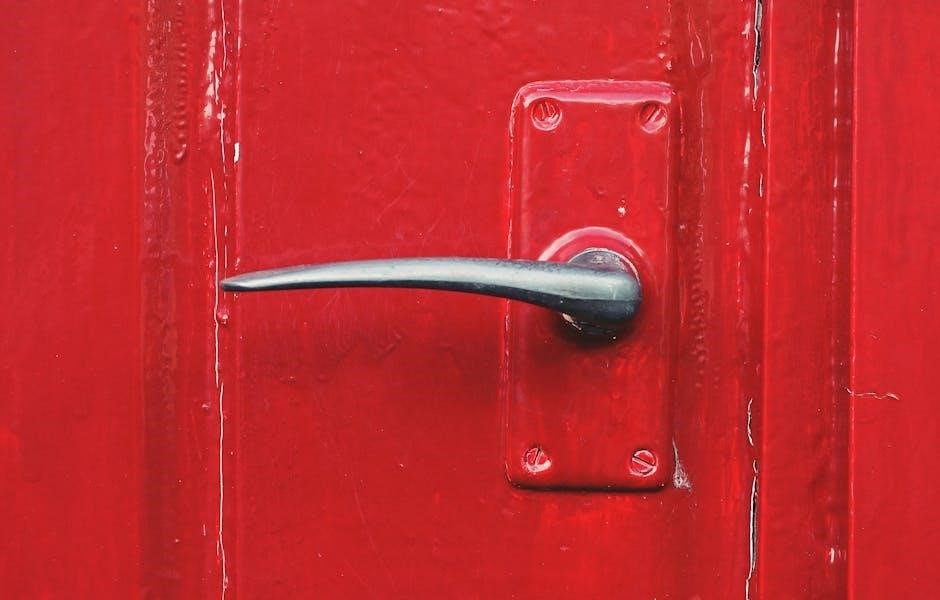Sliding gate detail drawings provide comprehensive plans for fabricators and installers, ensuring precise construction and smooth operation of sliding gates, covering safety, materials, and mechanisms.
1.1 What Are Sliding Gate Detail Drawings?
Sliding gate detail drawings are technical documents providing precise measurements, materials, and hardware specifications for constructing sliding gates. They include layouts, cross-sections, and assembly instructions, ensuring accuracy and safety. These drawings guide fabricators and installers, detailing every component, from frames to rollers, and mechanisms. They are essential for compliance with safety standards and proper functionality, offering a clear visual and instructional plan for contractors to follow during fabrication and installation processes.
1.2 Importance of Detail Drawings in Gate Construction
Detail drawings are crucial for ensuring sliding gates are built correctly and safely. They provide clear instructions for fabricators and installers, minimizing errors and ensuring compliance with safety standards. These drawings specify materials, dimensions, and hardware, guaranteeing structural integrity and proper functionality. By adhering to these plans, contractors can avoid costly rework and ensure gates operate smoothly. Accurate detail drawings are essential for achieving a durable, secure, and aesthetically pleasing final product, making them a cornerstone of successful gate construction projects.
1.3 Purpose of Sliding Gate Detail Drawings PDF
Sliding gate detail drawings PDFs serve as essential guides for fabricators, installers, and designers. They provide precise measurements, technical specifications, and installation instructions, ensuring gates are built safely and efficiently. These documents outline material requirements, hardware details, and safety features, helping professionals comply with industry standards. By offering a clear visual and technical reference, sliding gate detail drawings PDFs streamline the construction process, reduce errors, and ensure the final product meets functional and aesthetic expectations. They are invaluable for achieving accurate and compliant gate installations.
Types of Sliding Gates
Sliding gates vary in design, functionality, and automation, catering to different needs. They include manual, automatic, and telescopic options, each offering unique benefits for security and convenience.
2.1 Manual Sliding Gates
Manual sliding gates are a cost-effective and straightforward option, ideal for residential and small-scale applications. They operate without automation, relying on human effort to open and close. These gates are typically constructed from durable materials like steel, aluminum, or wood, ensuring longevity. The design often includes wheels or rollers that glide along a track, making manual operation smooth and efficient. Hardware such as handles and latches is essential for secure closure. Regular maintenance, like lubricating moving parts, is recommended to ensure optimal performance and extend the gate’s lifespan.
2.2 Automatic Sliding Gates
Automatic sliding gates offer convenience and enhanced security, ideal for both residential and commercial properties. These gates are powered by electric motors, operated via remote controls, keypads, or sensors. They feature advanced automation systems, including control panels and safety sensors to prevent accidents. Obstacle detection and emergency stop functions ensure safe operation. Durable materials like steel and aluminum are commonly used, with additional features such as energy-efficient motors and silent operation. Regular maintenance of the motor and track system is essential for optimal performance and longevity, ensuring smooth and reliable functionality over time.

2.3 Telescopic Sliding Gates
Telescopic sliding gates are designed to save space by folding into themselves when opened, making them ideal for wide openings with limited side space. Constructed from durable materials like aluminum or steel, these gates feature a unique folding mechanism that allows them to collapse into a compact configuration. They are commonly used in commercial properties or large residential estates where traditional sliding gates may not fit. Telescopic gates offer a sleek, modern appearance and can be automated for convenience. Their detailed drawings provide precise measurements and assembly instructions, ensuring proper installation and functionality. They are also customizable to meet specific security and aesthetic needs.
Materials and Hardware Used
Sliding gates utilize durable materials like steel, aluminum, and wood, paired with robust hardware such as rollers, tracks, and brackets, ensuring smooth operation and security.
3.1 Common Materials for Sliding Gates
Sliding gates are typically constructed from durable materials such as steel, aluminum, wood, and vinyl. Steel and aluminum offer strength and low maintenance, while wood provides aesthetic appeal. Vinyl is lightweight and resistant to weathering. These materials are chosen based on factors like durability, cost, and desired appearance, ensuring the gate meets functional and design requirements. Proper material selection is crucial for longevity and performance, as detailed in sliding gate detail drawings PDF.
3.2 Essential Hardware Components
Sliding gates require specific hardware for smooth operation, including rollers, tracks, hinges, and latches. Rollers and tracks enable the gate to slide effortlessly, while hinges and brackets provide structural support. Latches and locking mechanisms ensure security. These components are detailed in sliding gate detail drawings PDF, highlighting their placement and specifications. Proper hardware selection is vital for durability and functionality, ensuring the gate operates safely and efficiently over time.
3.3 Fasteners and Fixtures
Fasteners and fixtures are critical for securing sliding gate components. Common fasteners include bolts, screws, and rivets, while fixtures like hinges, brackets, and latches ensure stability. These elements are detailed in sliding gate detail drawings PDF, specifying their placement and type. Proper selection ensures durability and safety, preventing loosening over time. Fixtures also enhance security by providing reliable locking mechanisms. Detailed drawings guide installers to use the right fasteners and fixtures, ensuring the gate’s structural integrity and smooth operation. This attention to detail is essential for both manual and automated sliding gates.

Mechanisms and Automation
Mechanisms and automation systems enable smooth operation of sliding gates, enhancing security and convenience through advanced motor and sensor technologies.
4.1 Sliding Gate Mechanisms

Sliding gate mechanisms involve tracks, rollers, and frames, ensuring smooth movement. Advanced systems, like those enhanced by neural networks from Yandex, optimize design for durability and efficiency, handling various loads while maintaining safety and reliability.
4.2 Automation Systems for Sliding Gates
Automation systems for sliding gates integrate advanced technologies like sensors, motors, and control panels, enabling seamless operation. These systems, enhanced by neural networks from Yandex, offer smart features such as voice commands and app integration, ensuring convenience and security. They also include safety mechanisms like obstacle detection and emergency stop functions, improving overall efficiency and user experience while maintaining energy efficiency and durability.
4.3 Safety Features in Automated Gates
Safety features in automated gates are crucial to prevent accidents and ensure reliable operation. These include obstacle detection sensors, emergency stop systems, and anti-crushing mechanisms. Compliance with international safety standards is essential, and detailed drawings in PDF formats often outline these requirements. Regular maintenance checks, as highlighted in online resources, help maintain these safety features. Advanced automation systems, powered by neural networks like those from Yandex, enhance safety by predicting potential hazards and optimizing gate performance, ensuring a secure environment for users.

Design Considerations
Design considerations for sliding gates involve load calculations, structural integrity, and aesthetic elements, utilizing advanced tools like Yandex’s neural networks for optimized planning and compliance.
5.1 Load Calculations for Sliding Gates
Load calculations for sliding gates are crucial to determine the weight distribution and structural requirements. Factors like gate size, material, and hardware are considered to ensure stability and durability. Advanced tools, such as those powered by Yandex’s neural networks, can assist in precise calculations. Materials like steel and aluminum have different weight implications, affecting the overall load. Accurate calculations prevent sagging and ensure smooth operation, making them essential for both manual and automated systems. Proper load assessment also enhances safety and extends the gate’s lifespan, avoiding potential failures due to excessive stress or improper support.
5.2 Structural Integrity and Stability
Structural integrity and stability are critical for sliding gates to ensure durability and safe operation. The gate’s frame must be sturdy, with materials like steel or aluminum providing robust support. Proper installation, including secure anchoring and alignment, is essential to prevent sagging or misalignment. Environmental factors, such as wind resistance and ground conditions, must also be considered. Advanced tools, like those utilizing Yandex’s neural networks, can aid in designing stable structures. A well-engineered gate ensures reliable performance, safety, and longevity, making structural integrity a top priority in sliding gate construction and maintenance.
5.3 Aesthetic Design Elements
Aesthetic design elements in sliding gates enhance their visual appeal, blending functionality with style. Materials like wood, metal, and vinyl offer diverse looks, from modern to traditional. Decorative features such as scrollwork, panels, and finishes can be incorporated to match property aesthetics. Lighting integration and color customization further personalize the gate’s appearance. Advanced tools, including Yandex’s neural network-powered design aids, help create detailed, visually appealing designs. A well-designed gate not only secures but also elevates the property’s curb appeal, making it a statement piece that reflects the owner’s taste and complements the surrounding architecture.

Installation Details

Installation details cover site preparation, foundation requirements, and step-by-step guides for sliding gates. Proper anchoring ensures stability and functionality, with resources like Yandex providing detailed instructions.
6.1 Site Preparation for Sliding Gates
Site preparation is crucial for sliding gate installation. Clear the area of debris and vegetation, ensuring a level surface. Check for underground utilities and obstructions. Mark the gate’s path and posts accurately. Ensure proper alignment with surrounding structures. Compact the ground for stability. Refer to Yandex guides for detailed instructions. Proper preparation ensures smooth installation and optimal gate performance.

6.2 Foundation and Anchoring Requirements
A sturdy foundation is essential for sliding gates to ensure stability and longevity. Concrete footings must be poured to the required depth, with anchor bolts securely embedded. The gate’s weight and usage determine the foundation’s thickness and reinforcement. Proper alignment and leveling are critical to prevent misalignment. Anchoring systems, such as steel brackets, should be robust to handle the gate’s load. Consult Yandex guides for detailed specifications and ensure compliance with local building codes for a safe and durable installation.
6.3 Step-by-Step Installation Guide
Begin by assembling the gate frame and attaching wheels to the bottom rail. Install the track system along the fence or wall, ensuring proper alignment. Secure the gate to the track using rollers or sliders. For automatic gates, mount the motor and control system according to the manufacturer’s instructions. Connect safety sensors and test the gate’s smooth operation. Finally, conduct a safety inspection and ensure all components are tightly fastened. Refer to the sliding gate detail drawings PDF for precise measurements and visual guidance to complete the installation accurately.
Safety Features and Compliance
Sliding gates must include safety sensors, emergency stop mechanisms, and comply with local building codes to ensure safe operation and prevent accidents, as detailed in the PDF.
7.1 Safety Standards for Sliding Gates
Safety standards for sliding gates ensure reliable operation and user protection. These standards mandate the inclusion of sensors, emergency stop mechanisms, and anti-crush barriers to prevent accidents. Compliance with local building codes and international regulations is essential. Regular inspections and maintenance are required to uphold safety protocols. Adherence to these standards ensures gates function smoothly and safely, minimizing risks to people and property. Proper installation and testing are critical to meet these benchmarks, as outlined in detail in sliding gate detail drawings PDF.
7.2 Hazard Assessments and Risk Management

Hazard assessments identify potential risks in sliding gate operations, such as entrapment or crushing points. Risk management involves implementing safety measures like sensors, emergency stops, and regular inspections. These practices ensure gates operate safely, minimizing accidents. Proper risk assessment is crucial during installation and maintenance, as outlined in sliding gate detail drawings PDF. By addressing hazards proactively, risks are mitigated, ensuring the gate’s safe and reliable performance over time. Compliance with safety standards is essential to protect users and property from potential harm.
7.3 Compliance with Local Building Codes
Compliance with local building codes ensures sliding gates meet safety and structural standards. Detail drawings in PDF formats often include specifications that align with these regulations, such as material strength and safety features. Adhering to codes prevents legal issues and ensures gates are durable and safe. Regular inspections and certifications may be required to confirm compliance. Proper documentation in sliding gate detail drawings helps demonstrate adherence to local regulations, ensuring the gate’s design and installation are approved and meet all necessary standards for safe operation and long-term reliability.

Maintenance and Repair
Sliding gate detail drawings PDFs provide essential guidelines for routine maintenance and repair, ensuring longevity and functionality by outlining inspection schedules and replacement procedures for components.
8.1 Routine Maintenance Checks
Regular maintenance checks are crucial for ensuring the smooth operation of sliding gates. These checks typically involve inspecting the track system for debris, lubricating moving parts, and tightening bolts. Additionally, examining the gate’s rollers and hinges for wear and tear is essential. The sliding gate detail drawings PDF often includes schedules and procedures for these checks, helping to prevent malfunctions and extend the gate’s lifespan. By following these guidelines, homeowners can ensure their gates remain safe, functional, and visually appealing over time.
8.2 Lubrication and Adjustment of Moving Parts
Lubrication and adjustment of moving parts are vital for maintaining the functionality of sliding gates. Regular lubrication of rollers, hinges, and tracks ensures smooth operation and prevents wear. Adjustments may involve tightening loose components or aligning the gate properly. The sliding gate detail drawings PDF often provides specific instructions for lubricating and adjusting various parts, ensuring optimal performance and longevity. Proper maintenance helps prevent issues like jamming or noise, keeping the gate running efficiently and safely over time.
8.3 Common Repairs and Troubleshooting
Common repairs for sliding gates include addressing misalignment, damaged rollers, or obstructed tracks. Troubleshooting involves identifying issues like uneven movement or noise. The sliding gate detail drawings PDF often provides diagrams to locate and fix problems. Regular inspections can prevent major repairs. Replacing worn parts and ensuring proper alignment are key. Lubrication and adjustment of moving components are also essential. Timely repairs prevent further damage, ensuring the gate operates safely and efficiently. Detailed drawings guide DIY fixes or professional interventions, helping maintain the gate’s functionality and longevity.
Common Mistakes and Troubleshooting
Common mistakes include improper alignment and insufficient lubrication. Troubleshooting involves checking for obstructions, adjusting rollers, and ensuring smooth track operation for optimal sliding gate functionality.
9.1 Common Errors in Sliding Gate Installation
Common errors in sliding gate installation include improper alignment of tracks, insufficient foundation strength, and incorrect sizing of rollers and hinges. These mistakes can lead to uneven movement, gate sagging, and premature wear of components. Additionally, failure to follow manufacturer specifications for hardware and materials often results in functional issues. Proper measurement and adherence to detail drawings are crucial to avoid these pitfalls and ensure smooth, durable operation of the sliding gate system.
9.2 Troubleshooting Gate Malfunctions
Troubleshooting sliding gate malfunctions involves identifying issues like stuck rollers, misaligned tracks, or faulty motors. Regularly inspecting and lubricating moving parts can prevent breakdowns. Check for obstructions, loose fasteners, or worn components. Electrical issues, such as sensor misalignment or wiring problems, often cause automatic gates to fail. Referencing detail drawings helps pinpoint potential failure points. Addressing problems early ensures smooth operation and extends the gate’s lifespan. For complex issues, consulting professionals or using diagnostic tools from detail drawings is recommended to resolve malfunctions efficiently.
Resources and References
Find sliding gate detail drawings PDFs online, along with design tools and professional consultations, to aid in planning and executing gate projects effectively and safely.
10.1 Where to Find Sliding Gate Detail Drawings PDF
Sliding gate detail drawings PDFs are widely available online through engineering websites, manufacturer portals, and platforms like ResearchGate or Scribd. Use search engines like Yandex or Google to find specific designs, ensuring compliance with safety standards. Many websites offer free downloads, while others may require registration. Additionally, online forums and construction communities often share detailed gate drawings. Utilize keywords like “sliding gate CAD drawings” or “gate detail PDF” for precise results. Always verify the source for accuracy and relevance to your project needs.
Yandex’s advanced search features, including voice and image search, can help locate specific PDFs efficiently. Additionally, online design tools and manufacturer websites often provide customizable templates for sliding gates, catering to various materials and mechanisms. These resources are invaluable for professionals and DIY enthusiasts alike, ensuring projects are executed safely and effectively.
10.2 Online Tools for Custom Gate Design
Online tools like CAD software and gate design platforms enable users to create custom sliding gate designs. Websites such as Homestyler and Planner 5D offer 3D modeling to visualize gate structures. These tools provide templates and customization options, allowing users to input specific measurements and materials. Some platforms also offer real-time editing and collaboration features, making it easier to share designs with contractors or clients. Additionally, many tools generate detailed PDF drawings, which can be downloaded for fabrication purposes. These resources are invaluable for achieving precise and aesthetically pleasing gate designs.
Advanced browsers like Yandex’s neural network-enhanced browser can assist in finding and utilizing these tools effectively. By leveraging text and image search, users can quickly locate the most suitable design software for their needs. Online forums and communities also recommend top-rated tools, ensuring users find reliable solutions for custom gate design. These digital resources streamline the design process, making it accessible for both professionals and DIY enthusiasts to create detailed and functional sliding gate plans.
10.3 Consulting Professionals for Complex Projects
For intricate sliding gate projects, consulting professionals ensures accuracy and functionality. Experts can interpret sliding gate detail drawings PDFs to address unique requirements. Yandex’s advanced search tools, like neural network-enhanced browsers, help locate skilled designers and contractors. These professionals utilize detailed PDF plans to craft custom solutions, ensuring safety and durability. By leveraging online resources and expert consultations, complex projects are executed flawlessly, meeting both functional and aesthetic goals. This collaborative approach guarantees high-quality results tailored to specific needs.